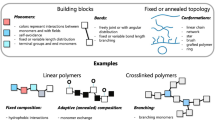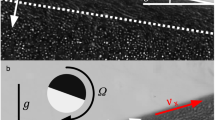Abstract
Over 200 years after Coulomb’s studies1, a general connection between the mechanical response of a granular material and the constituents’ shape remains unknown2,3,4,5,6,7,8,9,10. The key difficulty in articulating this relationship is that shape is an inexhaustible parameter, making its systematic exploration infeasible. Here we show that the role of particle shape can, however, be explored efficiently when granular design is viewed in the context of artificial evolution11. By introducing a mutable representation for particle shapes, we demonstrate with computer simulation how shapes can be evolved. As proof of principle, we predicted motifs that link shape to packing stiffness, discovered a particle that produces aggregates that stiffen—rather than weaken—under compression, and verified the results using three-dimensional printing. More generally, our approach facilitates the exploration of the role of arbitrary particle geometry in jammed systems, and invites the discovery and design of granular matter with optimized properties.
This is a preview of subscription content, access via your institution
Access options
Subscribe to this journal
Receive 12 print issues and online access
$259.00 per year
only $21.58 per issue
Buy this article
- Purchase on Springer Link
- Instant access to full article PDF
Prices may be subject to local taxes which are calculated during checkout





Similar content being viewed by others
References
Coulomb, C. Mémoirs de Mathématique et de Physique 343–384 (L’Imprimerie Royale, 1773).
Jaeger, H. M., Nagel, S. R. & Behringer, R. P. Granular solids, liquids, and gases. Rev. Mod. Phys. 68, 1259–1273 (1996).
Duran, J. Sands, Powders, and Grains: An Introduction to the Physics of Granular Materials (Springer, 1999).
Pena, A. A., Garcia-Rojo, R. & Herrmann, H. J. Influence of particle shape on sheared dense granular media. Granu. Matter 9, 279–291 (2007).
Zuriguel, I. & Mullin, T. The role of particle shape on the stress distribution in a sandpile. Proc. R. Soc. Lond. A 464, 99–116 (2008).
Haji-Akbari, A. et al. Disordered, quasicrystalline and crystalline phases of densely packed tetrahedra. Nature 462, 773–777 (2009).
Torquato, S. & Jiao, Y. Dense packings of the Platonic and Archimedean solids. Nature 460, 876–879 (2009).
Schreck, C. F., Xu, N. & O’Hern, C. S. A comparison of jamming behavior in systems composed of dimer- and ellipse-shaped particles. Soft Matter 6, 2960–2969 (2010).
Liu, A. J. & Nagel, S. R. The jamming transition and the marginally jammed solid. Annu. Rev. Condens. Matter Phys. 1, 347–369 (2010).
Van Hecke, M. Jamming of soft particles: Geometry, mechanics, scaling and isostaticity. J. Phys. Condens. Matter 22, 033101 (2010).
Eiben, A. E. & Smith, J. E. Introduction to Evolutionary Computing (Springer, 2003).
Zou, L. N., Cheng, X., Rivers, M. L., Jaeger, H. M. & Nagel, S. R. The packing of granular polymer chains. Science 326, 408–410 (2009).
Baker, J. & Kudrolli, A. Maximum and minimum stable random packings of Platonic solids. Phys. Rev. E 82, 061304 (2010).
Jaoshvili, A., Esakia, A., Porrati, M. & Chaikin, P. M. Experiments on the random packing of tetrahedral dice. Phys. Rev. Lett. 104, 185501 (2010).
Wood, D. M. Soil Behavior and Critical State Soil Mechanics (Cambridge Univ. Press, 1990).
Galindo-Torres, S. A., Alonso-Marroquin, F., Wang, Y. C., Pedroso, D. & Munoz Castano, J. D. Molecular dynamics simulation of complex particles in three dimensions and the study of friction due to nonconvexity. Phys. Rev. E 79, 060301 (2009).
Majmudar, T. S. & Behringer, R. P. Contact force measurements and stress-induced anisotropy in granular materials. Nature 435, 1079–1082 (2005).
Brown, E., Nasto, A., Athanassiadis, A. G. & Jaeger, H. M. Strain-stiffening in random packings of entangled granular chains. Phys. Rev. Lett. 108, 108302 (2012).
Hansen, N., Muller, S. D. & Koumoutsakos, P. Reducing the time complexity of the derandomized evolution strategy with covariance matrix adaptation (CMA-ES). Evol. Comput. 11, 1–18 (2003).
Lipson, H. & Pollack, J. B. Automatic design and manufacture of robotic lifeforms. Nature 406, 974–978 (2000).
Oganov, A. R., Lyakhov, A. O. & Valle, M. How evolutionary crystal structure prediction works—and why. Accounts Chem. Res. 44, 227–237 (2011).
Pöschel, T. & Schwager, T. Computational Granular Dynamics: Models and Algorithms (Springer, 2005).
Kodam, M., Bharadwaj, R., Curtis, J., Hancock, B. & Wassgren, C. Force model considerations for glued-sphere discrete element method simulations. Chem. Eng. Sci. 64, 3466–3475 (2009).
Tolley, M. T. & Lipson, H. On-line assembly planning for stochastically reconfigurable systems. Int. J. Robot. Res. 30, 1566–1584 (2011).
Arkus, N., Manoharan, V. N. & Brenner, M. P. Minimal energy clusters of hard spheres with short range attractions. Phys. Rev. Lett. 103, 118303 (2009).
Hoy, R. S., Harwayne-Gidansky, J. & O’Hern, C. S. Structure of finite sphere packings via exact enumeration: Implications for colloidal crystal nucleation. Phys. Rev. E 85, 051403 (2012).
Sloane, N. J. A., Hardin, R. H., Duff, T. D. S. & Conway, J. H. Minimal-energy clusters of hard-spheres. Discrete Comput. Geom. 14, 237–259 (1995).
Papanikolaou, S., O’Hern, C. S. & Shattuck, M. D. Isostaticity at frictional jamming. Preprint at http://arxiv.org/abs/1207.6010 (2012).
Potyondy, D. O. & Cundall, P. A. A bonded-particle model for rock. Int. J. Rock Mech. Mining Sci. 41, 1329–1364 (2004).
Acknowledgements
We thank E. Brown, J. Ellowitz, S. Nagel, S. Waitukaitis and T. Witten for insightful discussions, and A. Athanassiadis and M. Collins for help with the 3D-printed particles. We would like to acknowledge and thank the Itasca Education Partnership (Itasca Consulting Group) for the contribution of software and technical support. This work was supported by the NSF through its MRSEC program (DMR-0820054) and by the US Army Research Office through grant W911NF-12-1-0182.
Author information
Authors and Affiliations
Contributions
M.Z.M. and H.M.J. conceived the study and wrote the paper. M.Z.M. created the particle-shape representation, performed the simulations and experiments and analysed the data.
Corresponding author
Ethics declarations
Competing interests
The authors declare no competing financial interests.
Supplementary information
Supplementary Information
Supplementary Information (PDF 978 kb)
Rights and permissions
About this article
Cite this article
Miskin, M., Jaeger, H. Adapting granular materials through artificial evolution. Nature Mater 12, 326–331 (2013). https://doi.org/10.1038/nmat3543
Received:
Accepted:
Published:
Issue Date:
DOI: https://doi.org/10.1038/nmat3543
This article is cited by
-
Science and Technology of Additive Manufacturing Applied to Geotechnical Engineering
Indian Geotechnical Journal (2024)
-
What is shape? Characterizing particle morphology with genetic algorithms and deep generative models
Granular Matter (2023)
-
Structured fabrics with tunable mechanical properties
Nature (2021)
-
Triaxial compression behavior of 3D printed and natural sands
Granular Matter (2021)
-
Geotechnical properties of 3D-printed transparent granular soil
Acta Geotechnica (2021)



